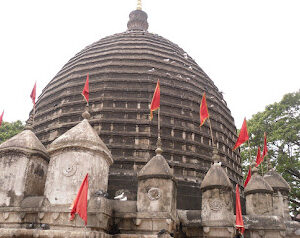Ajmer Sharif Dargah (also Ajmer Dargah Shareef, Ajmer Sharif or Dargah Sharif) is a Sufi Tomb (dargah) of the Sufi saint, Khwaja Moinuddin Chishti, located at Ajmer Shareef, Rajasthan, India.
Location
Ajmer Sharif Dargah is 2 kilometres (1.2 mi) away from the main central Ajmer Railway station and 500 metres away from the Central Jail and is situated at the foot of the Taragarh hill.
Background
Main article: Mu’in al-Din Chishti
Moinuddin Chishti was a 13th-century Sufi saint and philosopher. Born in Sanjar (of modern-day Iran), or in Sijistan, he arrived in Delhi during the reign of the Sultan Iltutmish (d. 1236). Moinuddin moved from Delhi to Ajmer shortly thereafter, at which point he became increasingly influenced by the writings of the famous Sunni Hanbali scholar and mystic ʿAbdallāh Anṣārī (d. 1088), whose famous work on the lives of the early Islamic saints, the Ṭabāqāt al-ṣūfiyya, may have played a role in shaping Moinuddin’s worldview. It was during his time in Ajmer that Moinuiddin acquired the reputation of being a charismatic and compassionate spiritual preacher and teacher; and biographical accounts of his life written after his death report that he received the gifts of many “spiritual marvels (karāmāt), such as miraculous travel, clairvoyance, and visions of angels” in these years of his life.
History
Moinuddin seems to have been unanimously regarded as a great saint after his passing. The tomb (dargāh) of Muʿīn al-Dīn became a deeply venerated site in the century following the preacher’s death in March 1236. Honoured by members of all social classes, the tomb was treated with great respect by the era’s most important Sunni rulers. The 13th-century Sultan of Delhi Iltutmish paid a famous visit to the tomb in 1232 to commemorate the memory of the saint. In a similar way, the later Mughal Emperor Akbar (d. 1605) visited the shrine no less than fourteen times during his reign. He also made a pilgrimage to this tomb in 1566, with his Hindu consort, Mariam-uz-Zamani barefoot in the hopes of having sons born to them. He also reconstructed the tomb’s sanctum sanctorum in 1579. Jahangir, Shah Jahan, and Jahanara later renovated the structure. An elegant covering over the dargah was constructed in 1800 by the Maharaja of Baroda.
Local and national rulers came to pray here, the dargah grew in popularity and size over the years. Razia Sultana, Nasiruddin Mahmud, Muhammad bin Tughluq, Sher Shah Suri, and Akbar, Mariam-uz-Zamani and his descendants Jahangir, Shah Jahan, Aurangzeb, Dara Shikoh and Jahanara Begum were known to have visited the shrine.
In the present day, the tomb of Moinuddin Chishti continues to be one of the most popular sites of religious visitation for Sunni Muslims in the Indian subcontinent, with over “hundreds of thousands of people from all over the Indian sub-continent assembling there on the occasion of [the saint’s] ʿurs or death anniversary.” Additionally, the site also attracts many Hindus, who have also venerated the Islamic saint since the medieval period.
In 2019, the Hindustan Zinc Limited decided to renovate the complex under the Swachh Bharat Abhiyan, including many plans specifically targeted at sanitation and hygiene.




















Reviews
There are no reviews yet